Warning: Undefined property: stdClass::$title in /usr/home/nunnsrog1/public_html/structuresolver/website_d/plugins/system/tabsaccordions/src/Sets.php on line 635
Structural Modeling
StructureSolver lets you create balanced forward models of the hangingwall structures associated with movement on faults.
You can interactively change the models until you have matched the observed structures in your seismic or geologic section.
Through this process you create value by:
- Constraining fault shapes and cross-fault correlations
- Clarifying structural kinematics and the interplay between faulting and sedimentation.
- You can simply create a structural model based on any fault in your Interpretation.
- StructureSolver rigorously incorporates scientific principles to model the folding that takes place in the hangingwalls of growth faults.
- StructureSolver seamlessly integrates structural growth and sedimentation so you can model both extensional and contractional growth structures.
- You can simply control all principal variables while continuously overlaying the resulting model over a seismic or geological cross section.
- This multi-variable interactivity helps you to quickly gain insights into the structures you are modeling.
Mississippi Canyon Structural Model
This example illustrates how StructureSolver analysis can create value when analyzing large extensional growth faults, such as those found in the Gulf of Mexico and other passive continental margins. In such systems, the fault traces themselves may be well imaged using modern seismic data. Stratigraphic correlations may be well established from well control in the shallow section but unknown in the deeper section. Such systems often have very large displacements and interpreters quite often underestimate the amount of growth in the deep section.
In this example, StructureSolver is used to confirm the upper level stratigraphic correlations and to confirm and refine the fault shape. The combination of convex and concave curvatures on the fault provides significant geometric constraints. After this is done, a good estimate of the deeper stratigraphic correlations is readily obtained.
In some sections we have studied, there was very early salt movement in the core of the extensional growth structure. In such cases, careful analysis of discrepancies between the deep modeled and observed geometries can help you estimate the amount and timing of salt movement.
Step-by-step Sequence of Analysis
 Import image of depth converted seismic interpretation; in this case a Mississippi Canyon growth fault from Xiao and Suppe(1991). Note the overall rollover together with “reverse drag” near the fault. The top four surfaces correlate on the footwall and hangingwall of the fault. The deepest five hangingwall surfaces have not been interpreted on the footwall side of the fault.
Import image of depth converted seismic interpretation; in this case a Mississippi Canyon growth fault from Xiao and Suppe(1991). Note the overall rollover together with “reverse drag” near the fault. The top four surfaces correlate on the footwall and hangingwall of the fault. The deepest five hangingwall surfaces have not been interpreted on the footwall side of the fault.
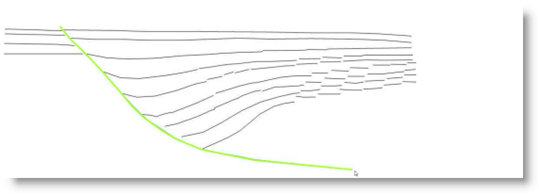
Digitize fault trajectory in StructureSolver – assuming that the existing interpretation is correct (which will be confirmed).
 Add the uppermost four undeformed uppermost surfaces at their footwall levels. The synthetic and antithetic shear surfaces are automatically displayed.
Add the uppermost four undeformed uppermost surfaces at their footwall levels. The synthetic and antithetic shear surfaces are automatically displayed.
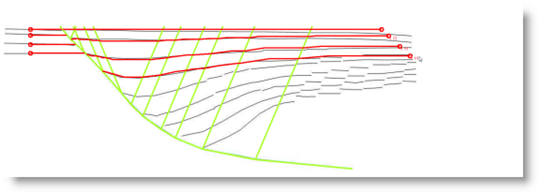 Stretch the hanging wall layers by a constant growth factor by dragging the deepest surface with the cursor. The model geometry conforms very well with the observed shapes, confirming that the fault shape is indeed controlling deformation. The main rollover is caused by the concave bends on the fault, the “reverse drag” by the small convex bends.
Stretch the hanging wall layers by a constant growth factor by dragging the deepest surface with the cursor. The model geometry conforms very well with the observed shapes, confirming that the fault shape is indeed controlling deformation. The main rollover is caused by the concave bends on the fault, the “reverse drag” by the small convex bends.
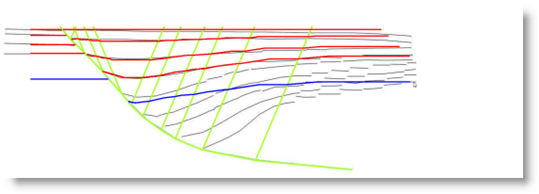 Add a surface corresponding to the deepest hangingwall surface. By default, it is assumed that the reference thickness of the overlying layer is the same on the footwall side of the fault (no growth). Because the structure does not match this assumption is clearly incorrect.
Add a surface corresponding to the deepest hangingwall surface. By default, it is assumed that the reference thickness of the overlying layer is the same on the footwall side of the fault (no growth). Because the structure does not match this assumption is clearly incorrect.
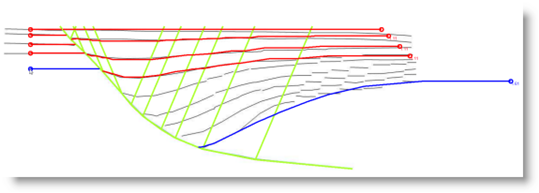 Match the deepest structural surface by dragging the footwall surface upwards, thereby reliably establishing the footwall correlation of the deepest hangingwall surface.
Match the deepest structural surface by dragging the footwall surface upwards, thereby reliably establishing the footwall correlation of the deepest hangingwall surface.
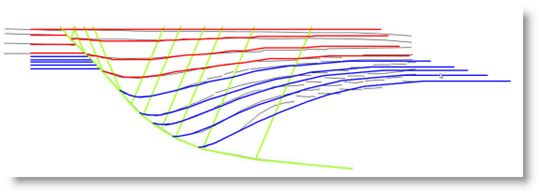 Add intervening surfaces that match the hanging wall cutoff. The model is now complete and accounts for about 90% of the observed structure. The fault trajectory and deformational mechanism is confirmed and deeper correlations established.
Add intervening surfaces that match the hanging wall cutoff. The model is now complete and accounts for about 90% of the observed structure. The fault trajectory and deformational mechanism is confirmed and deeper correlations established.
- You simply choose to add structural surfaces to any fault in your interpretation.
- StructureSolver will automatically configure the set of kink axes that control the deformation within the hangingwall of the fault, and will let you add undeformed structural surfaces using mouse movements and clicks.
- You can subsequently deform the shapes of the surfaces you have added by modifying your structural model.
- Add new surfaces to an already partially constructed and deformed structural model
- Delete or redefine structural surfaces.
- Modify the shape of the controlling fault using any interpretation function.
- Manipulate structural surfaces using the functions Stretch Overlying Layers, Move Underlying Layers and Move Individual Surface
- Change the deformation shear angle in real time
You will typically use StructureSolver to model actual structures that are visible on an image of a seismic or geologic section.
The flexibility with which you can create and modify models creates many different opportunities for creative use.
If footwall and hangingwall strata are well-defined in both geometry and correlation, you can use StructureSolver to refine the fault shape.
- Interpret a first estimate of the fault geometry.
- Add structural surfaces and set the footwall reference levels to their observed levels.
- Move the hangingwall reference points so that the hangingwall reference levels are matched, or alternatively so that the hangingwall cutoffs are matched.
- If you are confident of the hangingwall cutoffs you may wish to lock them at this stage.
- Refine the fault shape until the entire hangingwall geometry is matched.
- The overall hangingwall fold dimension will constrain the dip on the deepest parts of the fault.
- Details of normal and reverse "drag" near the fault will constrain details of minor convex and concave bends in the fault.
If the fault and hangingwall geometries are well constrained, you can use StructureSolver to define the correlations across the fault.
- Interpret the fault
- Add structural surfaces at the hangingwall reference levels.
- Adjust the footwall reference levels until the hangingwall rollover geometry and cutoffs are matched.
StructureSolver can be very effective at analyzing systems of faults. You should start by modeling the gross geometry of each major fault. This helps you understand the overall kinematic picture and the interaction of faults in time and space.
StructureSolver modeling also often does a good job of approximating the displacement patterns of synthetic and antithetic faulting in the hangingwalls of large faults. Thus while you a modeling a single large fault you can gain important insights into the formation of the minor faults within its hangingwall.
Rhone Delta Structural Model
The seismic section from the Rhone Delta extension shows a complex extension patten above a shallow dipping weak detachment.
Despite the structural complexity most of the structural development can be modeled using two listric faults.
- Movement on the left fault generally predates movement on the right fault, although there is a period of overlap. The left fault has a simple listric shape. The net effect of growth across this fault is simple rotational fanning.
- The right fault has a convex pillow superimposed on its overall listric shape (probably associated with movement on the left fault). Synthetic deformation axes associated with this pillow produce the pronounced syncline. The structural deformation pattern could not be effectively modeling without taking into account both synthetic and antithetic shear axes. In the observed section there are numerous small synthetic faults whose patten matches the modeled shear pattern.
The modeling quite strongly constrains the correlations across both faults.
Data courtesy of TGS-Nopec.
StructureSolver can handle contractional growth structures fairly well. The geometry of the kink axes does not conform to flexural slip deformation however. A fairly steep (nearly 90 degree) shear angle gives a good overall approximation for contractional growth structures. Future versions of StructureSolver may incorporate more sophisticated definitions of contractional deformation axes.
Lost Hills Contractional Growth Structure
In this example StructureSolver is used to model a contractional growth structure, approximately duplicating the model produced by Don Medwedeff for the Lost Hills Anticline.
A near vertical shear angle is used to approximate flexural slip folding. Nevertheless the main features of Medwedeff's model are rapidly reproduced. A good estimate of the deeper fault ramp is also obtained.
In a similar way StructureSolver can be used to model the deepwater contractional growth structures that are found offshore the Gulf Coast and offshore parts of West Africa.
Cross-section image from Medwedeff, D. A., 1989,"Growth Fault-Bend Folding at Southeast Lost Hills, San Joaquin Valley, California": AAPG Bulletin, Volume 73-1, pages 54 - 67.
- You interpret faults, horizons and markers as simple curves identified with descriptive categories.
- Faults and horizons automatically have special properties for structural modeling and restoration. Markers are undifferentiated events.
- All drawing and curve editing functions apply equally to faults, horizons and markers and require minimal specification:
- You can simply set the active curve category for drawing by clicking on an existing curve or by selecting from a list.
- You can modify or delete any point on any curve in a single editing operation
- To add points, split, or join curves, you first identify curve segments with a single click
- You can easily delete or reassign curves and delete or redefine entire curve categories.
- No special preparatory steps are needed before creating or modifying a structural model or performing a structural restoration.
- When you edit a fault that has structural model, the model automatically changes.
- All graphical operations use a consistent set of mouse movements and clicks.
- Real-time instructions are shown in a status bar and dynamic information is shown in a dynamic label that follows the cursor
- StructureSolver does not have in-built functions to import digital interpretations, because of the wide variety of formats that would need to be supported.
- If you have an interpreted seismic or geologic section in another system, the best approach is to save an image of the interpreted section and then import that image into StructureSolver. You can then very rapidly draw over the existing interpretation with new active faults and horizons. In almost all circumstances this approach is quicker than a digital export/import procedure.
- For customers who have recurrent requirements to transfer digital interpretations from another system, we can assist in writing file transfer utilities that will write data to and from StructureSolver solutions data format.
- Absolutely. Individual faults can each have their own structural models and can also offset horizons that are selected for restoration.
The principles and assumptions are described in Xiao and Suppe (1992, Origin of Rollover, AAPG Bulletin, V. 76, No. 4). Xiao and Suppe showed that the shapes of rollover folds are controlled by a number of variables, including:
- The shape of the fault
- The history of sedimentation rate relative to fault slip
- The total slip after each bed is deposited.
- The direction of relative rock motion in hangingwall collapse
- Compaction.
StructureSolver lets you model all of these variables with the exception of compaction.
Structural Modeling Basics
They showed that there are two different types of deformation axes associated with extensional fault bends.
- Antithetic kink axes originate at concave-upwards bends and are responsible for the rollover that takes place towards the master fault.
- Synthetic kink axes originate at convex-upward fault bends and are responsible for the misnamed "normal drag" in which beds are deformed so that they dip away from the master fault.
A combination of deformation across antithetic and synthetic shear surfaces produces the more complex structures that we commonly see in nature.
Another important insight in Xiao and Suppe's work was the recognition of growth axial surfaces, whose inclination depends on the relationship between fault slip rate and sediment growth rate.
Xiao and Suppe's approach to modeling 2-D structural deformation above extensional faults has been shown to be highly accurate in many common and important situations. If faults have both convex and concave bends, the approach is significantly more accurate than modeling approaches that assume a uniform deformation angle within the fault hangingwall. Xiao and Suppe (1992) illustrate numerous examples where models match reality very impressively. StructureSolver users have also found this to be the case.
You do not need to explicitly specify fault slip rates and sedimentation rates to construct a StructureSolver model. Instead you specify reference depths for footwall and hangingwall beds in an easy graphical fashion by grabbing and moving reference points on either footwall or hangingwall structural surfaces. The footwall reference depth for a bed is equivalent to the depth of its footwall cutoff on the fault, assuming that the footwall strata are horizontal. The hangingwall reference depth for a bed is its depth at a distance far enough away from the fault that it is beyond the most distal kink axis.
If the cross-section you are analyzing is not parallel to the principal displacement direction, then you will get erroneous results. Likewise you should carefully consider whether there have been multiple phases and directions of strain.
If there are layers of mobile salt or shale in your section, the model will not account for these. However, StructureSolver modeling can sometimes be used to establish constraints on the timing and extent of movement of salt or mobile shale, by comparing the differences between the model and reality.
Although compaction changes the fault shape and the relationship between rollover and fault shape, Xiao and Suppe concluded that "under certain common conditions, the history of compaction can be neglected if the folding is modeled in the compacted state". These conditions are primarily that compaction factors change relatively smoothly in horizontal and vertical directions. This is not the case when there is significant overpressure in the footwall of faults.
- Both modeled structural surfaces and horizons are overlain on your seismic or geologic section and represent geological strata.
- You can control the names and display parameters (line thickness and color) in similar fashion.
- However whereas horizon segments are manually drawn and can have arbitrary shapes, modeled structural surfaces are automatically generated through the structural modeling process.
- Interpreted horizons can be used as reference horizons during structural restoration.
- Any displayed structural surfaces are transformed during structural restoration, but the surfaces themselves have no active role.
StructureSolver has three functions for adjusting modeled structural surfaces and the layers between them. These functions can be used on either the footwall or hangingwall of the modeled fault. You can create the same model by using any one of these functions in a series of operations, or by using an arbitrary combination of them in a series of operations. However, depending on the problem you are trying to solve, one or more of these functions may provide the most efficient approach.
- Stretch Overlying Layers allows you stretch (or contract) all the layers above a chosen surface by the same proportional amount. This function is very useful in situations where you suspect that you have pre-growth strata overlain by growth strata. Stretch Overlying Layers is the most efficient technique for creating simple models where the expansion ratio changes in a discrete fashion.
- Move Underlying Layers allows you to control the expansion ratio of the individual layer immediately above the surface that you are displacing, while preserving the expansion ratios of all other layers. There will be no change to the shapes of the surfaces above the surface that you are modifying. The shapes of the surface that you are moving, and all the surfaces below will change. However, the expansion ratios of all the underlying layers will remain the same. This function is useful when you want to model a structure in an incremental fashion from the top down.
- Move Individual Surface lets you move an individual surface on the footwall or hangingwall of a fault. The shape of the surface you are moving will change and the expansion ratios of the layer above and below it will change, but everything else will remain the same. This function gives you fine control of the position of an individual surface on the hanging wall or footwall of a fault.
This will be the case when you have convex bends on steep sections of a fault, or a very shallowly dipping final section of a fault. While you are modifying a fault or a structural surface you can go into fine control mode by holding down the Control key while you are moving points. In this mode the point you are moving will move only one tenth of the distance between its original position and the cursor position.
In this case you will see red circles on fault points. You can use Identify Fault Errors to diagnose the issues.
You will get warnings when the fault trace reverses dip or has a dip that exceeds the deformation shear angle.
Structural Modeling Errors and Warnings

